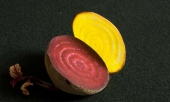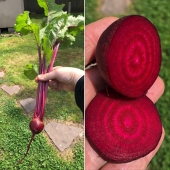A lot of different opinions and theories in this
thread! I am sure that different soils do impart different flavors to crops. I can also attest that some beats really do have subtly different flavors than others, which I assume to be a trait independent of where they're grown. I really love golden beets, which I think have a milder flavor, though I admit my dedication to golden beets is more due to the fact they don't turn my hands, clothes, cutting board, and generally everything else purple during the processing! And the striped chioggia beets really are super sweet, as advertised.
I suspect, though, that the widely varying perception of beets might partly also be a symptom of the reality that not all humans taste the same way (just ask any cannibal, LOL!). It isn't just a matter of opinion or individual preference; it is a well-established phenomenon that some people's taste buds are highly sensitive to certain chemical compounds that other people are either only slightly sensitive to or else completely blind to. I have experienced it myself. If this is the case with "dirty tasting" beets, then I suspect that nothing is going to much improve the situation for those who are biologically pre-disposed to sense whatever compound(s) beets contain that are the culprit.
Too bad for them, because I love beets! And they're very good for you. As I wrote above, I'd recommend trying different varieties, especially golden, that to me taste the least earthy. But then again, I don't feel that ANY beets taste particularly of "dirt," so it's possible that my own perceptions and advice just aren't applicable to those people who do taste them that way.
Or just focus on the beet greens, which are also super yummy, and give the
roots away or to the pigs and
chickens. Beet greens are a treat, with a delicate but distinct flavor extremely similar to Swiss chard (which is, after all, just a variety of beet bred for the tops instead of the roots). I've seen lots of good recipes for beet greens, but usually like to keep it simple: sauteed in butter and served with a dash of salt and a squirt of lemon. A good tip is to separate the larger stems from the greens when chopping them up, so that the stems can go into the pan first, as they take longer to cook; then add the greens at the end for just long enough to wilt them.
Okay, warning, tangent ahead:
Though I like to cook with golden beets and shred them raw on my salads, because they don't stain me, when brewing beet kvass I enjoy using dark red beets, because the resulting blood-colored drink just seems more fun to me than any lighter colored ferment would ; ) But kvass can sometimes be a bit too intensely beet tasting ...I shy away from saying "tastes like dirt," but I can almost see why some would think so. I've arrived at brewing "hybrid kvass" instead, which is a tip I read
online somewhere. If my crock of kvass starts with, say, two large beets, then I also add a quarter head of shredded cabbage and half an onion in thin slices. It isn't a precise recipe, but you
should end up with maybe an equal volume of beet chunks and cabbage/onion slaw. The resulting ferment has a taste much like kvass, but also sort of like kraut juice. I find it quite appealing! In particular, I crave it when I'm hungry but putting off a meal for a while longer; it just seems more hunger-satisfying than any drink should, probably because it's so salty.
A couple more beet kvass tips, tricks, and cheats...
1) If your kvass tastes a little weak, punch it up by slicing a garlic clove and soaking it either in the initial ferment or in the bottled drink. But go easy! It takes only a little garlic to turn the whole batch of kvass very distinctly garlicky tasting.
2) In my most recent batch, I washed the whole beats lightly in cold
water before cutting them up, but did NOT peel them. I figured the bacteria living on the skin could only help accelerate the fermentation. And the end product was first-rate kvass, so I guess it worked. Certainly didn't hurt any.
3) You can totally get a second soak out of your kvass solids. After 3-5 days of fermentation, drain the kvass and refill the crock of solids with more distilled water and a little more salt (maybe half what you used on the first soak). Give it another 3-5 days. But beware that your second soak won't be as strong-tasting as the first. I like to hold the first batch of kvass in the fridge, then mix it with the second, and bottle the result in order to even out the different intensities of the two soaks. In my
experience, a third soak ends up too weak to bother with.
4)
Reuse those spent kvass solids! Whether using pure beets or a hybrid mix as described above, I will save the drained solids when I'm done, grate the beet chunks, and incorporate the lot into my next batch of sauerkraut. Bonus: depending on the color of your cabbage, the ratio of kvass-solids-to-cabbage you use, and how well drained those kvass beets were (one soak or two or three), you might just end up with neon pink sauerkraut. I did once. And who wouldn't want that?! : )










 2
2




 3
3




 4
4




 2
2




 1
1








 3
3




 2
2




 3
3




 2
2




 3
3




 2
2




 2
2




 2
2




 2
2




 2
2




 2
2











